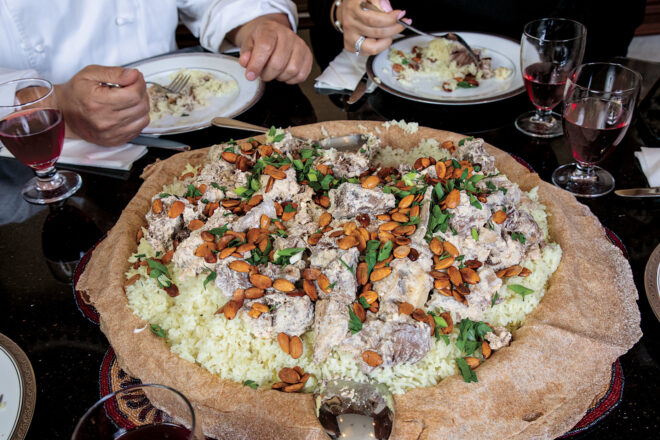Our continued investigation into sustainable Middle Eastern food focuses on Mansaf, the Jordanian national dish.
Regional cuisines evolve from foods that are available locally and in season. Eating this way implies sustainability from the very source, in addition to fair conditions for workers and mindful stewardship of natural resources.
When it comes to the delicious cuisines of Arabic countries, sustainable food often goes back to lamb. Hardy enough to thrive in the Middle Eastern climate, sheep were probably first domesticated here.
The taste for lamb remains a lively element in Arabic cuisine, although today many Arab countries import much of their lamb and mutton. See our post on fat-tailed sheep and their importance to Arabic cuisine. Another sustainable factor in sheep’s meat is the relatively small size of the animal, which makes a feast with no leftover waste.
Mansaf, which many consider the Jordanian national dish, perfected by Bedouin, traditionally nomadic people, is lamb cooked in jameed, or dried labneh (see our labneh recipe here).
Jameed is another example of using natural resources wisely. When there’s a surplus of milk, labneh is made, dehydrated by salting and straining it, hand-rolled into balls and allowed to dry until hard. It’s used to thicken sauces and flavor foods by re-hydrating. However, the recipe below uses fresh yogurt instead of jameed.
Mansaf, Jordanian Lamb Stew Recipe
serves 8-10
Ingredients
2 kilos lamb, preferably with bones, cut into thick pieces
2 cups yogurt
1 large onion, chopped
1 egg white, beaten with a fork until frothy
2 teaspoons corn flour
¼ cup clarified butter
¼ cup pine nuts
¼ cup slivered almonds
water
salt
freshly ground pepper
1½ teaspoons turmeric
½ teaspoon allspice
1 small piece cinnamon bark
3 cups basmati rice, rinsed
Method for making mansaf
Place yogurt in a heavy-based pan.
Add yogurt, frothy egg white, corn flour and 2-teaspoon salt to pan and stir gently just enough to blend. It is very important to use a wooden ladle and to stir in the same direction. So, if you stir to the left, you must continue stirring the yogurt mixture to the left throughout the whole cooking process. Otherwise, the yogurt will curdle.
Place pan over medium heat and stir constantly with wooden ladle. Heat the yogurt mixture until it begins to boil, stirring continuously in the same direction. Lower the heat and leave to boil gently, uncovered, for 3-5 minutes until thick.
Place lamb in a pan and cover with cold water. Bring slowly to boil. Skim the surface to remove particles. When well skimmed and boiling, add salt and paper to taste. Cover and boil gently for 30 minutes.
Heat butter in frying pan and add pine nuts and almonds. Fry until golden and remove pine nuts to a plate, draining butter back into the pan.
Add onion to pan and fry gently until transparent. Stir in turmeric, allspice and cinnamon bark and cook for another 2 minutes. Add this mixture to the boiling lamb.
After lamb has been cooking for 1 hour, remove lid and let liquid reduce until it only half-covers lamb.
When reduced, add yogurt sauce, shaking pan to blend it with liquid. Let the mixture boil gently on low heat until lamb is tender and sauce is thick.
In the meantime, prepare the rice as directed on package.
Once rice is cooked, remove it from pot and place it in a large round serving platter, then spread half of the nuts on top of rice.
When lamb is done, remove the meat chunks with a slotted spoon and place on top of rice and nuts platter. Then sprinkle the remaining nuts over entire platter.
Place the cooked yogurt in a large serving bowl.
Serve, and enjoy!
More on sustainable Middle Eastern foods:
Saudi Arabian Recipe: Chicken and Rice Kabsa
Eat The Whole Animal: Lamb’s Testicles
Above image via the NY Times





This looks wonderful. What is underneath the mansaf in the picture? It looks like a very flat bread of some sort.